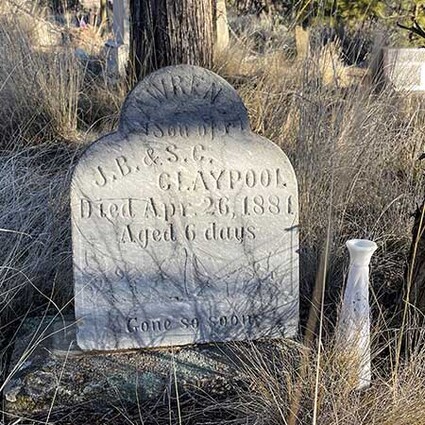Buried in history
Last updated 2/1/2022 at Noon
It’s a difficult word choice in describing the historic Camp Polk Cemetery, sometimes called Pioneer Cemetery. It’s also known by old-time families as Hindman Cemetery, labeled after the family of the same name who settled there once the Army camp closed in 1866.
John Hayes has written extensively about the cemetery, at one point saying: “The cemetery was established when the growing number of white settlers in the area needed a proper place to bury their dead. In 1880, the Hindman family set aside a portion of their homestead for that purpose. Although the cemetery was not associated with the military post, the name Camp Polk prevailed. The post office established by the Hindmans on their property bore the name Camp Polk and was recognized by both local residents and travelers.”
At first glance in walking the two-acre site, the word “disheveled” came to mind, but “rumpled” seem more fit for a place of such history and importance in Sisters Country’s legacy. Nobody will describe it as tidy, uncluttered, or well ordered. But that is part of its charm.
If you haven’t made the short drive to this remarkable site, you are encouraged to do so and take children or grandchildren along. Kids always like going to graveyards. Don’t ask me why. There will be nothing ghoulish to excite them as the place is free of imposing headstones, mysterious mausoleums, or witchy arbors, although many of the trees and nearly all of the shrubbery is in need of some overdue pruning.
It doesn’t have a hallowed-ground feel like a veterans’ cemetery, notwithstanding the many graves of veterans from both World Wars, Korea, and Vietnam. At least two dozen U.S. flags adorn various plots. Old Glory stands at the entrance, a little off center yet in good repair, not faded.
Volunteers and family descendants keep the place looking relatively cared for. There are scores of long-lasting artificial flower arrangements which, from a distance, almost look real given the state of the art in such things. Various dilapidated fences, benches, and ornaments give pause to wonder about the stories of both the buried and those who buried them.
Turns out, nobody owns the place. At least no person or entity is listed in country records. No taxes are assessed. Maintenance is 100 percent volunteer. But don’t assume you or your loved ones can be buried there in spite of no formal management. The plots are all taken, as in “possession is 9/10ths of the law” taken.
Family plots go back 140 years. While I only found marker number 323 as the highest number of burials, records list 325. It is widely assumed that a few dozen more are buried there as well in unmarked graves. Thomas Summers may be the oldest who was laid to rest, way back in July of 1880, as was Nellie Claypool that November.
James Taylor, when buried in September of 1896, was 90 — ancient by 19th-century standards. He’s a chap I’d like to have met.
What struck me the most was the headstone of Lawrence Claypool, who lived six days and was buried in April of 1881. A number of other graves are those of very young children as was usual for the last part of the 19th century before diphtheria, scarlet fever, and other diseases of the era were defeated by modern medicine. These markers will get the attention of any kiddos who tag along with you.
The last recorded burial was that of Dallas D. Rollins Hallingstad, laid to rest in August of 2020. Others will follow, those that are part of a family plot.
Sigmund Freud said that a high appreciation of death humor was a mark of maturity. Well, be prepared to find a goodly amount of death humor at Camp Polk Cemetery. Cowboy boots and hats, lariats, horse shoes — these are a few of the accoutrements hanging about, such as at the wooden headstone of Rodger J. Hall, The Cowboy Preacher “who rode into glory with his boots on.”
Elsewhere as you stroll the grounds on trodden, well-worn paths laid out in no particular order, you will find many mirthful opportunities. As well you will discover that a number of cemetery residents are buried with their beloved pets.
A distinct sign of life in Camp Polk Cemetery are the nearly dozen well-preserved bird houses affixed in varying locations. No doubt they are occupied during nesting season, their occupants singing to the dead.
It’s all rather tranquil, the cemetery, overlooking a meadow on two sides. To find your way from town, go out Camp Polk (the continuation of North Locust Street) for close to three miles and make the hard right where it meets Wilt Road. Drive about 300 yards to the first place you can turn left — Cemetery Road — and take it the quarter mile to where it dead-ends. (Did I just say “dead” ends?)


















Reader Comments(0)